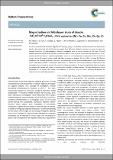A magnetisation and Mössbauer study of triazole (M1-x2+Mx3+)M3+F5(Htaz)1-x(taz)x weberites (M = Fe, Co, Mn, Zn, Ga, V)
Abstract
A series of triazole fluoride weberites (M1-x2+Mx3+)M3+F5(Htaz)1-x(taz)x is obtained by hydrothermal synthesis. All phases are found to be isostructural to ZnAlF5(Htaz) by powder X-ray diffraction. Weberite structures are prone to induce the magnetic frustration of antiferromagnetic interactions originating from the cationic topology of HTB layers. The (nD) magnetic properties of (0D) Co-Ga, (1D) Zn-Fe, (3D) Fe-Ga, Mn-Fe, Co-Fe and Co-V couples are thus reported. Co2+ or Fe2+ magnetic anisotropy induces a negative magnetisation below TN and compensation temperatures for Mn-Fe and Co-Fe couples. All iron 3D magnetic phases exhibit high Néel temperatures, between 81 K and 102 K, and large |θP/TN| ratios, signalling strong magnetic frustration. Their cation site occupancies and the deduced (de)protonation states of the amine are accurately determined by 57Fe Mössbauer spectrometry. In addition, this spectroscopy evidences a subtle effect of the atmosphere that surrounds the samples: the magnetic ordering temperatures TN decrease significantly when the samples are cooled under vacuum with respect to samples that are cooled at ambient pressure. This novel phenomenon, which is highlighted for all studied (3D) triazole iron weberites, is reversible, and thus provides promising perspectives for understanding the underlying mechanism.
Citation
Albino , M , Clark , L , Lhoste , J , Payen , C , Grenèche , J-M , Lightfoot , P , Maisonneuve , V & Leblanc , M 2017 , ' A magnetisation and Mössbauer study of triazole (M 1-x 2+ M x 3+ )M 3+ F 5 (H taz ) 1-x ( taz ) x weberites (M = Fe, Co, Mn, Zn, Ga, V) ' , Dalton Transactions , vol. 46 , no. 16 , pp. 5352-5362 . https://doi.org/10.1039/C7DT00587C
Publication
Dalton Transactions
Status
Peer reviewed
ISSN
1477-9226Type
Journal article
Description
Work at the University of St Andrews was supported by the Leverhulme Trust RPG-2013-343.Collections
Items in the St Andrews Research Repository are protected by copyright, with all rights reserved, unless otherwise indicated.

